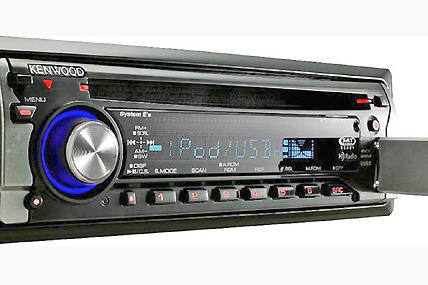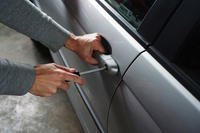Full iPod integration in an aftermarket head unit offers much better sound quality than FM modulators because the audio signal is fed directly into the head unit. And it also allows easy access to the music on the iPod through the head unit's own controls and provides information on the head unit's display. This way, you never have to touch your iPod after you hook it up to a head unit, which is a huge safety advantage as well as a major convenience.
But not all iPod-ready head units are created equal. Most offer basic controls that allow accessing music just as you would on an iPod: by artists, albums, songs, and playlists. And the head unit displays the corresponding info visually. One of the biggest factors you should think about when considering iPod integration is access speed.
Aftermarket iPod Adaptors
Leave it to the car audio aftermarket to give the people what they want. These days, what people want is to use their iPods while they're on the road, no matter what car they drive or whether they have an aftermarket head unit. Some people may not be willing or even able to change out their radios because of cosmetic or cost concerns or lease restrictions. That's where innovative car audio accessory companies such as Blitzsafe, PAC, Peripheral, PIE, and Scosche have come to the rescue.
Such companies may not be household names or even have the marquee value of other large and well-known car audio brands, but they are renowned in the car audio industry for providing solutions, largely to car audio specialty dealers, that integrate aftermarket electronics into almost any kind of vehicle. In the case of iPod integration, these companies offer adaptors that tap into a vehicle's factory wiring and electronics so that the popular music player can be added without high costs or hassles.
Auxiliary Inputs
Auxiliary inputs designed for plugging in a separate audio source have been around a long time, and they usually pop up like mushrooms after a rain storm when a new audio format comes on the scene. They were somewhat prevalent when CDs were still rare in car audio, for example, and people wanted to a plug a portable CD player into their car's cassette-based head unit. A car audio system I put together in the late 1980s, for example, had an aux-in on the back of the head unit, into which I plugged a portable CD.
Today, many aftermarket car audio head units sport aux inputs, as do an increasing percentage of new cars. Car manufacturers have recognized this as a feature that more and more consumers want. Although most are 3.5mm miniplug jacks (see Figure 7-4), which fit the same connector that an iPod and other MP3 player use, a few use RCA-based aux inputs like those found on most car and home audio components.
An aux-in jack is an easy and affordable way to jack an iPod (or any MP3 player or auxiliary audio source) into a car audio system, but you still have to fumble with the device to control it, which isn't very convenient or safe while behind the wheel. And it's not iPod-specific, which means you can plug in any outboard audio device.
Some car audio companies that don't make head units have also gotten in on the aux-in act. They allow an iPod or other MP3 player to be added into a system's signal chain on an amplifier, equalizer, or some other component.
Car Dealer Kits
BMW launched the first iPod integration application among carmakers in mid-2004, with a dealer-installed option that allowed owners of certain Bimmer models to control the device via steering-wheel audio controls. Information such as artist, album, and song can be displayed on the in-dash head unit. Since that time, fourteen more auto manufacturers have begun offering iPod integration kits. The obvious advantage of this approach to iPod integration is that you can keep a factory look.
Sync and the Future
As the iPod becomes more entrenched and widespread and other portable players come on the scene to challenge its dominance, look for more car-integration solutions to appear. Ford recently unveiled its Sync system, for example, which was developed in conjunction with Microsoft. It allows complete control of a portable music player via voice commands and steering-wheel switches, as well as cool features such as a "play similar" command that will automatically cull a playlist based on your music preferences.
USB in the Dash
An MP3 player syncs to Ford's Sync via a USB port, which has become as common as clover on all sorts of electronic products. Originally found on computers, USB (which stands for Universal Serial Bus) has quickly migrated to all sorts of electronics products as a quick way to transfer information. Now car audio systems, both aftermarket and stock, are beginning to sport USB ports.
Thumb Drives
Car audio head units have also begun to sprout USB drives on their front panels (see Figure 7-7). This allows easy and quick access to digital music files loaded on a USB thumb drive, a small flash-memory device that is about the size of a person's thumb. Depending on the capacity of the USB drive (which is measured in megabytes or gigabytes, with higher being better), it's possible to store dozens of songs on a drive small enough to fit in your pocket.
In the Cards: SD and MMC
Yet another way to carry MP3 files on the road is with Secure Digital (SD) and MultiMediaCards (MMC). You're probably familiar with these if you own a digital camera because many use the removable cards to store pictures. As with USB drives, the larger the capacity of the SD or MMC cards, the more tunes you can store on it, and the more expensive the card is. And because they are even smaller than USB drives, SD and MMC cards are a convenient way to carry dozens of MP3s on the road.
SD and MMC cards actually predate the presence of USB drives in the car audio world by several years, and SD cards have proven to be the dominant format. A few manufacturers @@md including Clarion, Dual, and Jensen - now offer SD card slots on their head units, typically behind a fold-down faceplate. And Audi, Mercedes, and Honda offer SD card slots in the dash on the OEM side.
Hard Disc Drives: Burn, Baby, Burn
Higher-capacity iPods and similar MP3 players are simply data storage devices with functions that allow you to access your tunes, whereas USB drives and SD cards are simply flash drives for temporarily storing your music files. But chances are you also store all of your tunes on your computer's hard drive and transfer it over to a hard-disc MP3 player or flash-memory device.So why not install a hard-disc drive (HDD) into your car and just dump all of your tunes on it? Well, several car audio manufacturers had the same idea a few years ago, about the time the whole iPod craze kicked in. But by that time, most people didn't want to go through the hassle of downloading their music to a hard drive in the car, which involved the tedious task of ripping songs from CDs one disc at a time, when they could have all the music on their iPod or other MP3 player. Subsequently, HDD head units never really caught on. There are still some around, and you can probably get a killer deal on one.
Some high-end head units these days use an HDD for the mapping database and operating system for GPS navigation because it offers fast access time.
The HDD has also found a home in some stock car audio systems. Cars from Cadillac, Chrysler, Dodge, Infiniti, and Lexus offer in-dash HDDs for storing hundreds of digital music files.
From Car Audio for Dummies, copyright © 2008 by John Wiley & Sons, Inc., Hoboken, New Jersey. Used by arrangement with John Wiley & Sons, Inc.










